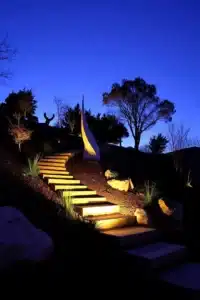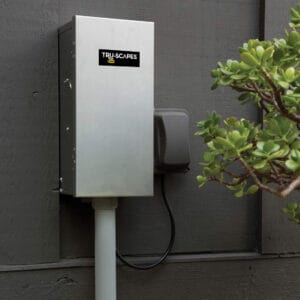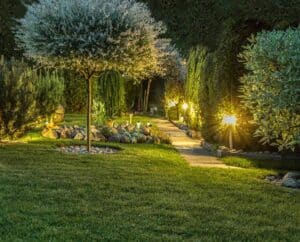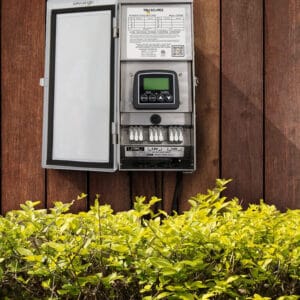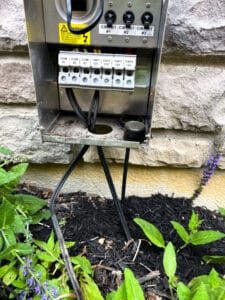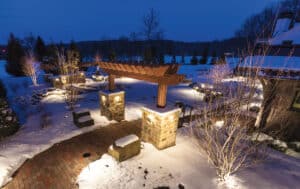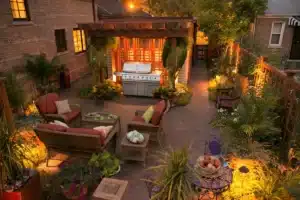Does your beautiful home seem to vanish the moment the sun goes down? You’ve invested in stunning landscaping and architecture, yet at night, it’s all lost to the darkness. You’re not alone. Many homeowners overlook the transformative power of a professional lighting scheme, missing an opportunity to enhance their home’s beauty, safety, and usability.
This isn’t about sticking a few lights in the ground. This is about creating a masterpiece. By the time you finish this article, you’ll understand the key outdoor lighting trends for 2025 that design professionals are using to create breathtaking effects. Get ready to turn your property into a welcoming, dramatic, and unforgettable nighttime showpiece.
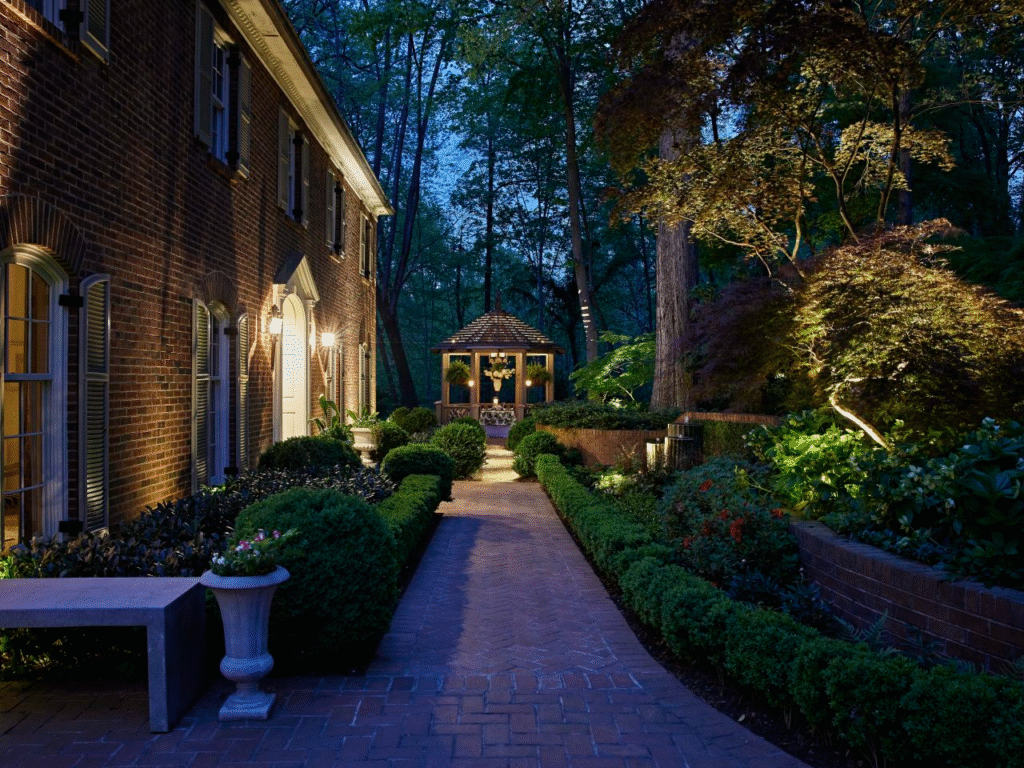
Trend #1: Warm, Layered Light is the New Bright
Gone are the days of blasting your home with a few harsh, cold floodlights. The leading trend for 2025 is creating depth and ambiance through layered lighting. Think of it like painting a picture, but with light. Professionals use a combination of techniques to build a rich, inviting scene. This works. Here’s why. It mimics the way we experience natural light, creating a comfortable and high-end feel.
- Ambient Lighting: This is the foundational layer. It provides a soft, general glow, often achieved with downlighting from trees or architectural eaves, creating a “moonlight” effect. It sets a serene mood and ensures safe navigation.
- Accent Lighting: This is where the magic happens. Accent lights, like discreet uplights, are used to strategically highlight your home’s best features. A spotlight can make a Japanese maple glow with color, or a “grazing” technique can bring out the rich texture of a stone wall.
- Task Lighting: This is the most functional layer, focused on specific areas. Gentle lights built into stair risers, under capstones on a seating wall, or near a grill make these spaces safer and more usable without ruining the overall mood.
By combining these layers, a lighting designer creates a cohesive and dynamic landscape that has texture, focus, and a warm, welcoming atmosphere.
Trend #2: Smart Systems for Effortless Control
Technology has officially made its way into the garden, and it’s one of the most practical outdoor lighting trends to emerge. Homeowners now expect the same convenience outdoors as they have indoors. Modern, professional-grade lighting systems are no longer just “on” or “off.” They are fully integrated smart systems you can control from your phone or tablet.
Imagine tapping a single button on your phone to switch your entire property from a soft, ambient “Welcome Home” scene to a brighter, more festive “Entertaining” mode.
Here’s what you gain with smart lighting control:
- Zoning: Group your lights into different zones. You can illuminate the front yard, backyard, and patio independently.
- Dimming: Adjust the brightness of each zone to create the perfect mood. Full brightness for a party, and a soft glow for a quiet evening.
- Scheduling: Automate your lighting to turn on at sunset and off at a designated time, ensuring your home is always beautifully lit without you lifting a finger.
- Durability: Unlike DIY smart bulbs, professional smart lighting systems are built around a robust, low-voltage transformer and durable fixtures designed to withstand the elements for years.
This level of control allows for unparalleled customization and convenience, truly extending your living space into the outdoors.
Trend #3: Putting Your Home’s Architecture in the Spotlight
Your home has a unique character. Why let it disappear at night? A major trend is using light to celebrate architectural details, turning your home’s facade into a stunning focal point. This approach treats the house itself as the most important feature of the landscape.
Skilled lighting designers use specific techniques to achieve this:
- Uplighting: Placing fixtures low to the ground and aiming them upward to highlight columns, peaks, and gables, adding a sense of grandeur and height.
- Wall Grazing: Positioning lights close to a textured surface, like brick or stone, and aiming the beam parallel to the wall. This creates dramatic shadows that reveal the material’s depth and character.
- Silhouetting: Placing a light source behind an architectural feature or ornamental tree to create a dark outline against a lit backdrop.
This focus on architectural lighting adds a layer of sophistication that makes a home look custom-designed and professionally curated.
Trend #4: Eco-Elegance with Low-Voltage LEDs and Dark Sky Principles
Being environmentally conscious doesn’t mean sacrificing style. In fact, the most elegant solutions are often the most efficient. This trend combines the power of low-voltage LED technology with responsible design principles that adhere to the standards set by the recognized technical and educational authority on illumination.
The Power of Professional-Grade LEDs
For years, low-voltage halogen was the standard. Today, integrated LED fixtures are the undisputed champion for high-end landscape lighting. For a full breakdown, you can review the difference between modern LEDs and traditional options.
| Feature | Traditional Halogen | Modern Integrated LED |
| Energy Usage | High | Up to 80% less energy consumed |
| Lifespan | 2,000 – 5,000 hours | 40,000 – 50,000+ hours |
| Durability | Fragile filaments break easily | Solid-state, highly durable design |
| Heat Output | Very hot, can be a burn risk | Minimal heat, safer for plants/pets |
| Color Options | Typically one warm, yellowish color | Wide range of warm whites available |
As you can see from the table and from the U.S. Department of Energy, the advantages of modern LEDs are clear.
Designing for the Dark Sky
A growing movement in upscale communities is Dark Sky-friendly lighting. This responsible approach ensures that light is directed only where it’s needed—downward, onto your pathways, patios, and landscape. It’s about being a good neighbor and preserving the beauty of the night sky.
This is achieved by using:
- Shielded Fixtures: Fixtures with hoods or caps that prevent light from spilling upward.
- Precise Placement: Aiming lights carefully to illuminate the target, not the air around it.
- Warm Color Temperatures: Learning the art of choosing a warm color temperature (around 2700K-3000K) is key, as it is less disruptive to wildlife and human sleep patterns.
This thoughtful approach proves that stunning outdoor lighting trends can be both beautiful and responsible.
Bringing the Trends Home: Why a Professional Matters
Reading about these trends is one thing; achieving them is another. A truly professional outdoor lighting system is more than just fixtures. It’s a cohesive plan designed by an expert who understands the art and science of light. A professional ensures proper voltage, buries wires safely, selects the right beam spreads for each application, and places fixtures to create a balanced, breathtaking final result that will last for decades.
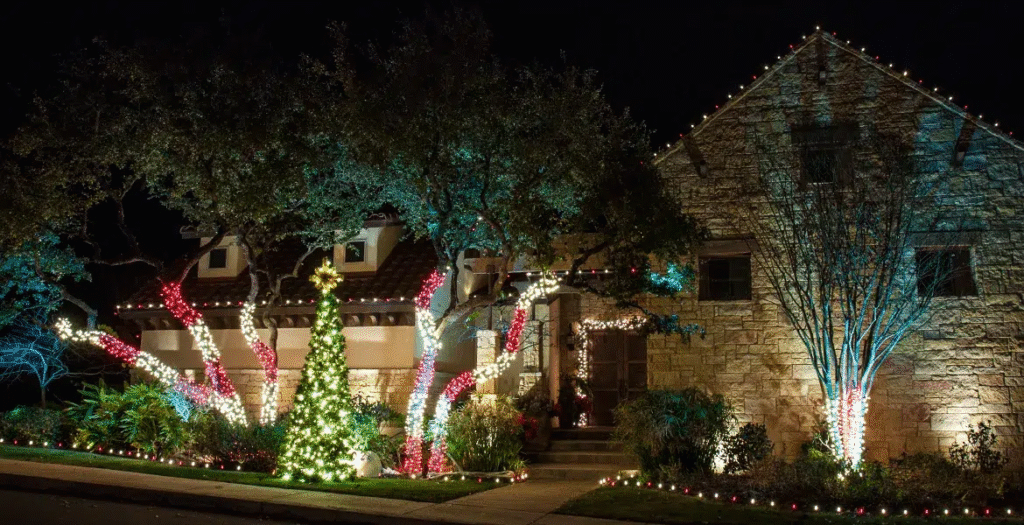
Your Home’s Nighttime Transformation Awaits
As we look to 2025, the message is clear: outdoor lighting has evolved from a simple utility into a sophisticated design element. By embracing warm, layered light, leveraging smart technology, highlighting your home’s architecture, and choosing efficient, responsible systems, you can do more than just light up your yard—you can create an experience. You can craft a home that’s not only beautiful and safe but is truly the envy of the neighborhood.
What are your thoughts on these 2025 outdoor lighting trends? Share your favorite look in the comments below or contact Tru-Scapes today for a professional design consultation to bring these ideas to life!

